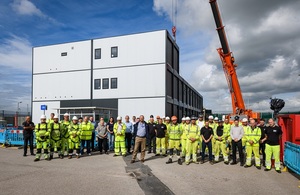Top US Space Force scientist visits Dstl
Press release
Dr Joel Mozer and his team met Defence Science and Technology Laboratory staff and toured the HERMES satellite ground control station at Portsdown West.

Dr Mozer is the Chief Scientist and Director Science, Technology and Research for the US Space Force (USSF). The visit on 8 September 2022 was his first to the UK’s Ministry of Defence since taking up his role in 2019.
Dr Mozer develops long-term military requirements for the Space Force and interacts with other international communities to address cross-organisational science and technical issues
During the visit – which was hosted by Athos Ritsperis, Dstl’s Deputy Space Systems Programme Manager for Science and Technology and Professor Richard Allington from the Defence Science and Technology Futures Programme – Dr Mozer and his team were provided with an overview of both programmes and introduced to senior technical staff from Dstl and UK Space Command.
Dstl’s Athos Ritsperis said:
This was a hugely important visit which included discussions on joint academic engagement and potential exchanges of both technical and Project Delivery staff. As part of the visit we showed our visitors the Dstl HERMES satellite ground control station, which is getting ready to manage its first Dstl Mission, due to launch from Spaceport Cornwall later this year.
Dr Mozer said:
I very much enjoyed my visit and feel that we have a very strong potential to collaborate on many fronts. I look forward to further engagements with with Dstl.
The space environment is an area of growing importance for defence science and technology. Opportunities for greater UK/US collaboration will enable vital knowledge-sharing including the application of futures techniques and a better understanding of trends, context and future science and technology possibilities.
Published 26 September 2022


